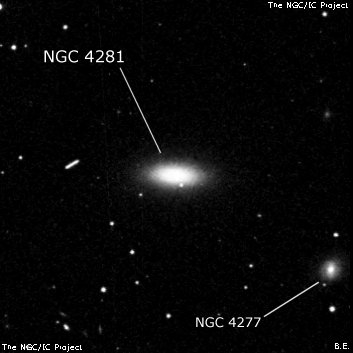
William Herschel discovered NGC 4281 = H II-571 = H II-573 = h1187 = h1194 on 17 Apr 1786 (sweep 553) and recorded "Four [NGC 4270, 4273, 4277 and 4281], the time and number is that of the last [NGC 4281]. They are scattered about." There is nothing near his position, but exactly one degree south is NGC 4281, the last of these four galaxies. He swept the field again 6 days later and measured an accurate position for NGC 4281, and simply noted (for II-573) "a nebula, but cloudy."
JH recorded the nebula as a "nova" on 27 Dec 1827 with the description "vB; E; bM; 60"." His RA was 47 sec too large (same error he made with NGC 4277 and 4273), so he didn't realize the equivalence with II-573. On a later sweep he observed H II-573 again, measured an accurate position and reported "vB, vL, R, pgbM, 3', 3 more seen." So, errors were made by both WH and JH, though Dreyer sorted things out pretty well in his 1912 publication of WH's catalogues.
400/500mm - 17.5" (3/28/87): fairly bright, moderately large, bright core, elongated 2:1 E-W. This galaxy is the last of 7 in a 15' circle and the brightest in the group along with NGC 4273 6.9' ESE.
600/800mm - 24" (4/28/14): bright, fairly large, elongated 2:1 E-W, 1.8'x0.9', sharply concentrated with an intensely bright core that increases to quasi-stellar nucleus. NGC 4268, 4273 and 4277 in a 10' string to the SW and NGC 4270 and 4266 lie to the NW.
Notes by Steve Gottlieb